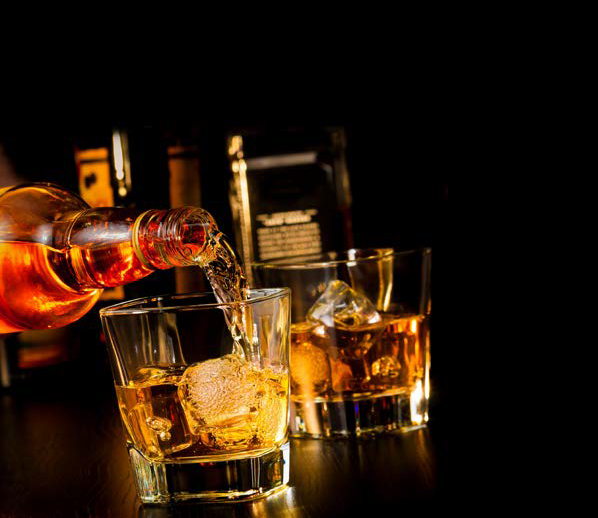Home » A quick guide to one of the world’s oldest medicines
Dean Fitzgerald is a community pharmacist with a keen interest in whiskey, and Irish whiskey in particular. Having graduated from Pharmacy in University College Cork in 2012, he is currently the Superintendent Pharmacist for the Irwin’s Pharmacy Group in Cork. Mr Fitzgerald shares his fascination with whiskey in his Instagram account The Whiskey Appreciation Society, and in this article, he provides an introduction to everything you need to know about whiskey.

“What whiskey should I buy?”, I’m often asked. My mind immediately shoots to Gene Wilder singing Pure Imagination, and I reply with several questions. “Isn’t there only three or four different brands of whiskey” I often hear in reply, and I respond, “Oh friend, ‘come with me and you’ll be in a world of pure imagination. . .’”.
Whiskey selection can be intimidating and confusing, with people generally picking a bottle from a brand they recognise, or an extravagant looking bottle. The (mostly Irish) whiskey renaissance has begun, so let’s try and demystify the contents of some bottles.

All whiskey starts out as the same three ingredients, water, grain and yeast. The main differences between whiskey types are grain/mash bill; production methods; and maturation in different wooden casks.
The market leader is single malt whiskey. Single malt simply means that the grain used in the production of the whiskey is 100% malted barley, and produced in a single distillery in copper pot stills.
Single malt is produced worldwide, Ireland included, with aged statements of single malts the backbone of the Scotch industry. You can expect a single malt to nose almost like a beer or stout (and sometimes tequila!), but also be floral, biscuity and welcoming.
A slight variation on single malt is if the malted barley is peated, and this produces a smoky flavoured whiskey. This style is synonymous with Islay (a Scottish Island) whiskey. Not for the faint hearted, peat can impart a smoky, campfire, iodine and almost medicinal profile, to a whiskey.
Ireland has a unique style of whiskey that has international protection with a technical file detailing the elements that must be met for it to be termed a single pot still (SPS) whiskey. Modern SPS must contain minimum percentages of both malted and unmalted barley and can contain a small amount of adjunct grains (such as rye, oats and wheat). Some say our unique style was developed to avoid a British malt tax in 1785, others say that it was simply down to the availability of grain.
The unmalted barley gives a spicier and more oily mouthfeel than a single malt. If other adjunct grains are also used (rye can increase the spice, oats can increase the creaminess of a distillate and wheat can give a honey note/texture), it can further diversify the whiskey. Pot still whiskey noses of cinnamon, Chinese five spice, light varnish and orchard fruits.
Bourbon is a unique style of whiskey synonymous with the United States. Bourbon mash bills must have ≥51% corn with the rest malted barley, rye or wheat. The high percentage of corn gives a much sweeter flavour profile. Tennessee whiskey must be made in the state of Tennessee, and the new make spirit is charcoal filtered before it is casked. Rye and wheat whiskeys are also very popular in America.
Grain whiskey is whiskey made from grains other than malted barley such as oats, wheat, rye, corn, and now even rice, quinoa, buckwheat and millet are being trialled. Working with these grains is difficult and can cause production issues. You can get some exceptional grain whiskey on their own with unique flavours, but generally they are used in blended whiskey. Like single malt, grain whiskey is produced in nearly all whiskey producing regions.
A blended whiskey consists of different types of whiskey blended together. Brands such as Jameson and Johnnie Walker are blends. Blends shouldn’t be viewed as an inferior product, and often contain superb whiskeys blended together. If a bottle or label does not state whether something is a single malt, pot still, or bourbon etc, then invariably, it is a blended whiskey.
Whiskey selection can be intimidating and confusing, with people generally picking a bottle from a brand they recognise, or an extravagant looking bottle.
The stills used for whiskey production lead to the phrases double distilled, triple distilled and column distilled. The majority of whiskey production is a batch process done in copper pear shaped pot — stills similar to pharmaceuticals production! Simply put, double distilled means the spirit has gone through a still twice before collection. Triple distilled has gone through three times, and continuously distilled means it was done with a column still — grain whiskey is produced via this method usually.
Triple distillation is historically an Irish technique, with our Scottish neighbours double distilling. Single pot still doesn’t have to be triple distilled, but it invariably is. Triple distillation is not a sign of purity or quality, with some double distilled products containing unique flavours not generally seen in a triple distilled product, but many Irish producers prefer to triple distil.
The clear spirit must be aged for a minimum of three years in a wooden cask for it to be classed as whiskey in the majority of territories. These wooden casks are vital, not only for storage or colouring, but also imparting flavour into the whiskey. Bourbon must be matured in virgin American oak casks that have been toasted/charred to call it a bourbon. These casks cannot be reused for bourbon, which may seem wasteful, but they then benefits the wider whiskey industry, as these casks are recycled for use worldwide.

Some argue that the grain and distillate give the unique flavours in whiskey and others argue it’s the cask. The answer probably lies somewhere in between. Generally, there is a maturation phase of a period of years in one cask and then the whiskey may be moved into a different cask to be ‘finished’, imparting a more dynamic flavour profile.
Certain casks can impart certain qualities on a whiskey, and any spirit that has a wooden cask maturation has probably held whiskey in it at some point afterwards. The following is a cask taste profile cheat sheet:
Wine, virgin oaks, tequila, fruit brandy’s, the list is endless! These all add nuances to a whiskey and there is a craft in barrel and wood selection in finding the right cask for a whiskey.
When a whiskey is being disgorged from casks it may have water added to it to reduce the alcohol content (or ABV), depending on the product desired. Whiskey must be bottled above 40% ABV, if it is below that it’s a whiskey liqueur. Above 50% ABV is generally classed as cask strength, and has had minimal water added. Generally, you won’t see anything above 65% ABC as it would knock over a small horse!
I’ve tried to distil down different whiskeys and styles to make them a bit more approachable. You may have more questions than answers at the end of this and if you do then congratulations, you’re interested in whiskey! Get in touch on Instagram if you have any questions and I’ll do my best to answer them — or it may spark another article. Sláinte!

Dean Fitzgerald can be found on Instagram @thewhiskeyappreciationsociety.